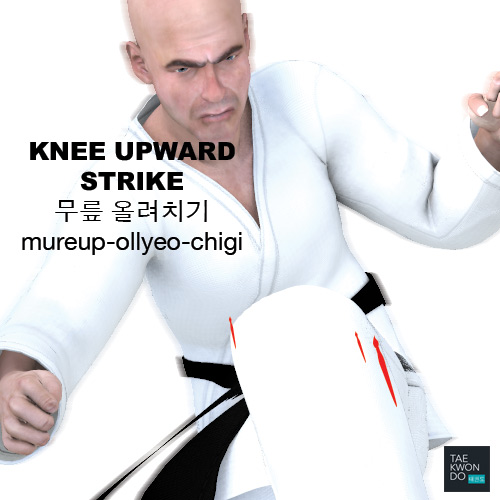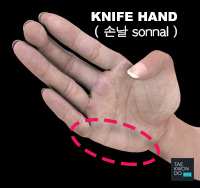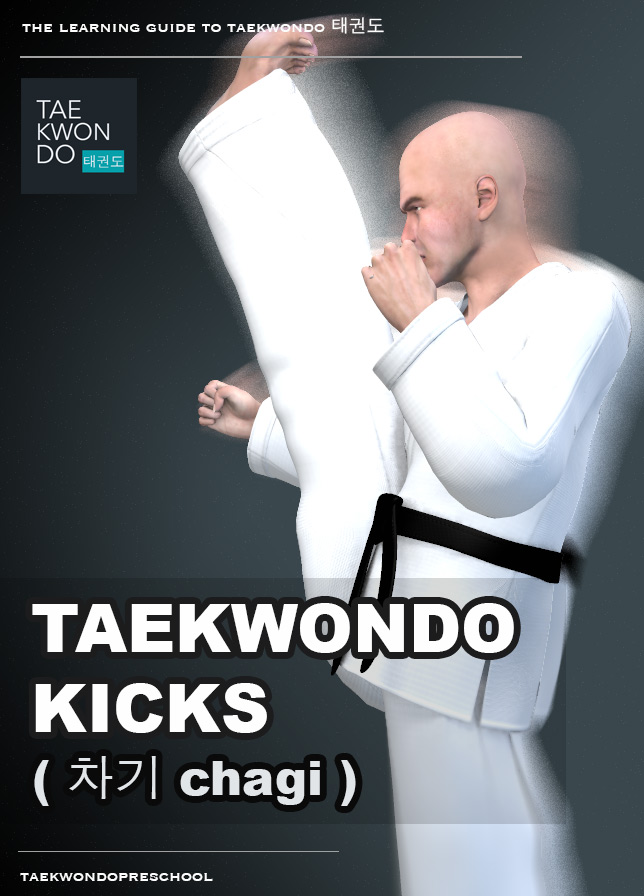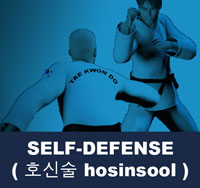Taekwondo 태권도Taekwondo Preschool
Promotion from one geup to the next can proceed rapidly in some schools, since schools often allow geup promotions every two, three, or four months. Students of geup rank learn the most basic techniques first, and then move on to more advanced techniques as they approach first dan. Many of the older and more traditional schools often take longer to allow students to test for higher ranks than newer, more contemporary schools, as they may not have the required testing intervals. View Taekwondo belt levels »

Knee Upward Strike
무릎 올려치기 mureup-ollyeo-chigi
A kick (차기 chagi) is a physical strike using the foot, leg, or knee. The striker relaxes to the extent possible during the strike, tensing the muscles of much of the body only at the time of impact, then relaxing again to recoil the striking part. Relaxation enables the strike to achieve the greatest possible velocity during travel, while rigidity at impact allows the maximum transfer of force.
Difficulty Level: Intermediate Technique: Kick ( 차기 chagi )
The Knee Upward Strike ( 무릎 올려치기 mureup-ollyeo-chigi ) is an intermediate level technique where the taekwondo practitioner raises the knee ( 무릎 mureup ) in an upward motion striking the opponent to the mid- or high-section. This kick ( 차기 chagi ) is typically performed in patterns ( 품새 poomse ), self-defense ( 호신술 hosinsool ), breaking ( 격파 gyeokpa ), promotion tests and demonstration events.
The kick ( 차기 chagi ) could potentially knockout a person if targeted to the sternum ( 흉골 hyung-gol ), chest ( 가슴 gaseum ), nose ( 코 ko ), jaw ( 턱 teog ), or face ( 얼굴 eolgul ) area which is lethal during combat situations. The taekwondo practitioner could also possibly target the groin ( 샅 sat ) during self-defense ( 호신술 hosinsool ) applications.
In World Taekwondo (WT) sparring ( 겨루기 gyeorugi ), the Knee Upward Strike ( 무릎 올려치기 mureup-ollyeo-chigi ) is not used. It is an illegal technique to use your knees ( 무릎 mureup ) to attack the opponent during sparring ( 겨루기 gyeorugi ) competitions which could lead to a penalty ( 감점 gamjeom ) or warning ( 경 고 gyeong-go ) from the referee.
Penalties on any prohibited acts shall be declared by the referee. Penalties are divided into warnings ( 경 고 gyeong-go ) and deduction penalty ( 감점 gamjeom ) based on the tournament point scoring system. The technique is more suited for self-defense ( 호신술 hosinsool ) usage.
Strikes should aim for a point 4–6 inches (10–15 cm) behind the target surface, to impart the most energy into the target. The striker in combat should attempt to strike through the target area, not just contact the surface.
Training Methods
How well one improves with training depends on several factors, such as the frequency it is engaged in, and the type of feedback that is available for improvement. If a student does not train often enough, reinforcement fades, and he or she is likely to forget what was learned.
During training, taekwondo practitioners may use various equipment and gear for practicing the kick ( 차기 chagi ). Taekwondo extensively uses the heavy bag for developing power and endurance. Powerful strikes to the heavy bag aren't recommended for inexperienced, or younger athletes, as risk of sprain, strain, or bone plate damage may adversely affect bone structures. It is highly recommended to carefully focus strikes to reduce chance of injury.
The kick ( 차기 chagi ) is best learned initially striking at the air as though there is an opponent but focusing on the form, speed, control, and technique; then moving on to soft surfaces striking punch mitts and target pads. Large heavy bags are used more for strength and endurance, while smaller targets such as punch mitts and target pads focus on faster kicking speed, timing and coordination. Target pads are useful for training mobility and accuracy on a moving target.
Difficulty of Technique
Taekwondo students of geup ranking learn the most basic techniques first, and then move on to more advanced and difficult techniques as they approach 1st Dan Black Belt. The more difficult the technique, the more practice may be needed for the purpose of improving or mastering it, as in the phrase 'practice makes perfect'. Every technique must display the requisite speed, balance, power and firmness to be realistically used as an attack or defense move.
* Please see a certified Master Instructor ( 사범님 sabeomnim ) for training. Proper guidance and instructions are needed to ensure safe training.
Promotion Tests
Students often undergo periodic testing and grading by their own Master Instructor ( 사범님 sabeomnim ) in order to advance to a higher level of recognized achievement such as a different belt color. They need to demonstrate their proficiency in the various aspects of the art such as the execution of patterns ( 품새 poomse ), which combine various techniques in specific sequences.
Knee Upward Strike ( 무릎 올려치기 mureup-ollyeo-chigi ) is a requirement for the below belt levels (Techniques vary between schools). Promotion from one belt level to the next can proceed rapidly in some schools, since schools often allow geup promotions every two, three, or four months. Students of geup rank learn the most basic techniques first, and then move on to more advanced techniques as they approach first dan black belt. View Promotion Tests »

Highlight Knife Hand ( 손날 sonnal ) Posture
By tucking the thumb into the palm, a surface called the knife hand or hand blade ( 손날 sonnal ) is formed. The surface extends with the muscle at the side of the hand located between the base of the small finger and the wrist ( 팔목 palmok ). The hand blade is used as both an offensive and defensive technique which can be executed as a high, low, middle, side, inward, outward, rising or circular. Use of this technique as both a strike and block is featured prominently in many of the World Taekwondo (WT) Taegeuk Poomse.
* Please see a certified Master Instructor ( 사범님 sabeomnim ) for training. Proper guidance and instructions are needed to ensure safe training.

Training Highlights Summary
The Kick ( 차기 chagi ) contains many key point highlights. There are some that are simple and straightforward but then some are complex and detailed that require repeated training to learn and master.
- raises one knee ( 무릎 mureup ) in an upward motion striking the opponent to the mid- or high-section
- the Knee ( 무릎 mureup ) has a hard surface which is suitable for striking the attacker
- could potentially knockout a person if targeted to the sternum, chest, nose, jaw, or face area
Strength Requirement of the Technique
Most strikes should generally be thrown with some measure of shifting body weight supporting the blow. The striker in combat should attempt to strike through the target area, not just contact the surface. Some strikes do not need as much strength as they target vulnerable areas such as the eyes ( 눈 nun ), neck ( 목 mok ) or sternum ( 흉골 hyung-gol ). The below is an approximate measurement of how much strength the strike requires from the practitioner to be effective.
Precision of Kicking ( 차기 chagi ) Technique
With proper execution opponents may be stopped with a single striking blow, which lessens the number of further strikes. Some kicks ( 차기 chagi ) can strike with more precision which will often cripple or knockout the opponent. The below is an approximate measurement of how precise the kick ( 차기 chagi ) requires from the practitioner to be effective.
Experienced practitioners learn through repetition and muscle memory when (not just how) to launch particular kicks ( 차기 chagi ), based on the circumstances they are facing.
* Please see a certified Master Instructor ( 사범님 sabeomnim ) for training. Proper guidance and instructions are needed to ensure safe training.
Risk of injury can be reduced by completing an effective warm up consisting of a heart raiser to get your pulse up, followed by sport specific dynamic stretches (stretches whilst moving). Please follow the guidance of a certified Master Instructor or trainer when doing sports related activities. Depending on the intensity of the exercise, cooling down can involve a slow jog or walk, or with lower intensities, stretching can be used. Cooling down allows the heart rate to return to its resting rate. View more information on Warming Up and Cooling Down ».
This article uses material from the Wikipedia articles "Warming Up" and "Cooling Down", which is released under the Creative Commons Attribution-Share-Alike License 3.0.
RESOURCES
This article uses material from the Wikipedia article "Kick" which is released under the Creative Commons Attribution-Share-Alike License 3.0.















































